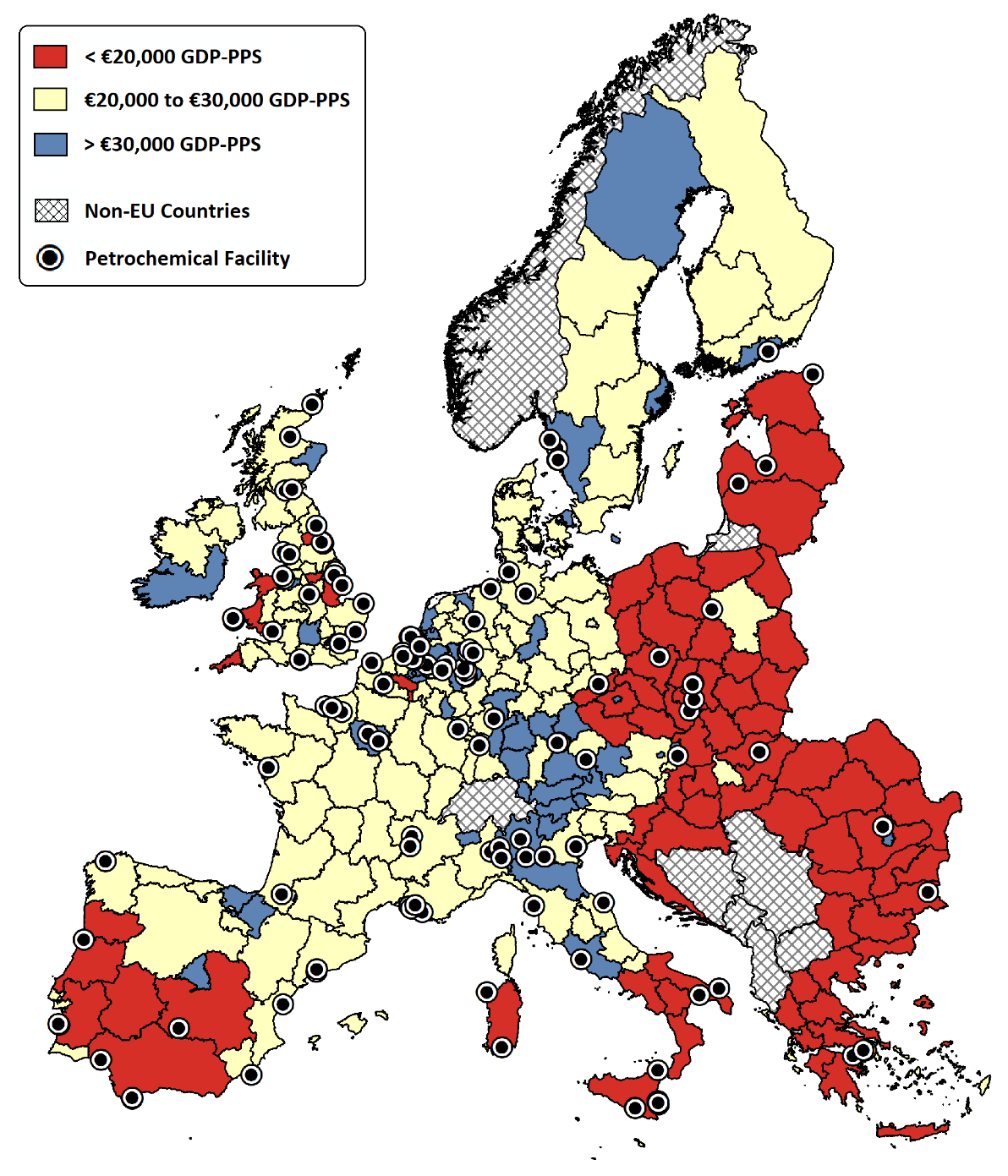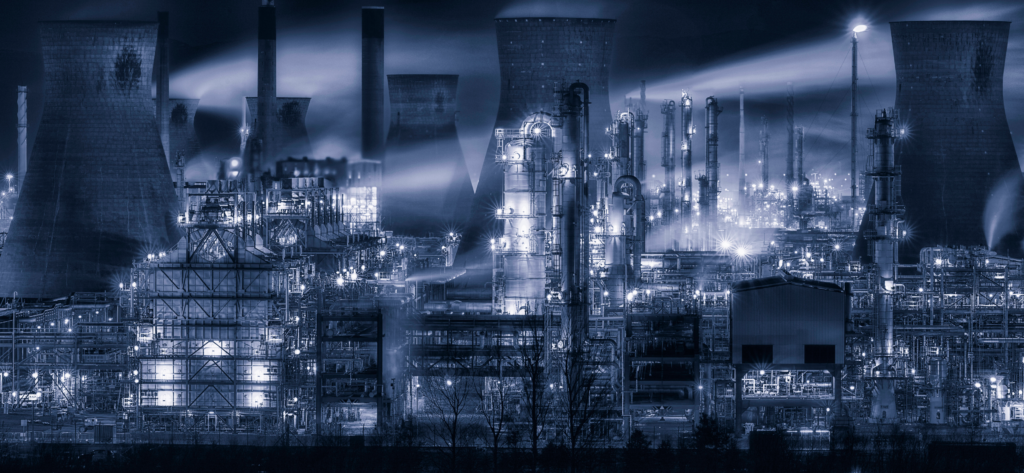Dr Calvin Jephcote, University of Warwick
Petroleum has been the fuel for dramatic change in the twentieth century, as a source of energy it has revolutionised transport and powered technological advances, but as a chemical it has also enabled humankind to engineer synthetic environments. The petrochemical industry was initially created from the desire to commoditise (the potentially toxic) by-products of the oil-refining industry, and has relatively recent origins, dating back to the manufacture of Bakelite plastic in 1907 and synthetic rubber in 1909. Petrochemicals are now classified as intermediate products of refining fossil fuels and form the building blocks for a host of essential everyday commodities, such as adhesives, detergents, fertilisers, pharmaceuticals, plastics, preservatives, and textiles.
The petrochemical industry remained a relatively experimental sector until the end of World War II (post-1945), as socioeconomic reconstruction projects urgently demanded access to inexpensive synthetic materials. Companies from the United States controlled 71% of the worlds refining capacity prior to 1945, establishing themselves as clear leaders in the emerging field of petrochemicals (Felton 2004).
For many years, the market dominance of these Anglo-American oil companies known as “the seven sisters” – BP, Chevron, Esso, Gulf, Mobil, Shell and Texaco – was maintained through vertical integration, and their ability to maintain high technological and geopolitical entry barriers for would-be competitors. Oil prices were set through their control of upstream exploration activities, which in turn limited the profit margin for potential competitors in down-stream activities (vertical integration). However, by 1970 the thirst for oil had begun to exert huge pressure on existing supply structures, as levels of global consumption rose to 46.2 million barrels per day – a 115% increase on levels reported in 1960 (Llewellyn et al 2013). In an increasingly globalised market, producing nations began to reclaim control of their oil resources and established an independent oil trade, which led to >300 private and 50 state-owned firms operating by 1972 (Llewellyn et al 2013).
European refining industries had previously been limited in size, restricted by the continents lack of crude-oil deposits – before the discovery of commercially viable North Sea oil in 1969. However, this period of rapid economic growth and an ample supply of cheap crude imports saw oil consumption in Europe rise from 12% of the global total in 1950, to 27% by 1970 (Molle 1984). Following this period of rapid growth, the European petrochemical industry has been challenged by periods of economic downturn and competition from emerging markets with access to low-cost ‘feedstock’. To remain economically viable, the European market was streamlined and sought to diversify its production from commodity to speciality chemicals.
The current landscape of the European petrochemical industry remains in part reflective of its historical roots, which in the 1950’s saw the strategic location of refineries around seaports receiving feedstock from overseas, later supplemented in the 1970’s by North Sea petroleum reservoirs.
This legacy is observed by the presence of petrochemical clusters in six out of the ten most active European ports, where upper estimates indicate that the industry is accountable for 34-64% of handled cargo (Eurostat 2015). These core locations include the historically important North Sea trade ports of Antwerp, Le Havre, Rotterdam and Immingham, and the Mediterranean ports of Algeciras and Marseille. Three ports contain chemical parks registered by the European Chemical Site Promotion Platform (ECSPP), which promotes integration and innovation across the industry.
FIGURE 1 illustrates this tendency for facilities to cluster either around historically important trade ports, or close to existing coastal industrial infrastructure in less affluent regions (Jephcote & Mah 2019). The petrochemical industry is also prominent within the Mediterranean islands of Malta and Sardinia, which are strategically positioned to process crude from Northern Africa and the Middle East for markets in mainland Europe. At present, 66% of European refineries are located within 10km of major trade ports (Jephcote & Mah 2019). Although coastal ports still dominate the petrochemical landscape, there has been a gradual shift towards inland markets –15% of European refineries were located at inland sites from 1950 to 1960, 28% in 1980, and approximately 44% by 2010 (Molle 1984, Jephcote & Mah 2019). For instance, the port of Genoa has become an important terminal that feeds refineries within the Milan-Turin-Genoa industrial triangle of north-western Italy, via a complex network of pipelines.

FIGURE 1: European petrochemical facilities operating between 2007-15 in relation to regional socio-economic status, as recorded by Gross Domestic Product per capita in Purchasing Power Standards (Jephcote & Mah 2019)
Jephcote & Mah (2019) identified the core of the European petrochemical network from ‘European Pollutant Release and Transfer Register’ (E-PRTR) records of 31,753 industrial operations, located within EU-28 Member States for the reporting period of 2007-15. This was achieved using a bottom-up approach, whereby a facilities involvement in the petrochemical industry was identified through releases of a tracer pollutant, benzene. Benzene is a natural component of crude petroleum at levels up to 4 g/l and is one of the elementary petrochemicals used to chemically synthesise new products, which may contain up to 15% volume benzene (WHO 2010a, IARC 1989). The World Health Organisation guidelines state that there are no safe levels of exposure to benzene (WHO 2010b).
Of the 156 identified petrochemical facilities, 28% operate in affluent regions (GDP-PPS > €30,000 per capita) and 27% are situated within relatively disadvantaged regions (GDP-PPS < €20,000 per capita). The most polluting facilities tend to be located within these financially disadvantaged regions, which report median benzene emissions of 12.6 tonnes per annum, compared to facility emissions of 5.1 tonnes per annum in affluent regions. 60% of the facilities in disadvantaged regions are near ports, compared to 47% of the facilities within affluent regions. In these affluent regions, 34% of the petrochemical industry focuses on manufacturing and 66% involve the refining of raw materials. In contrast, operations in disadvantaged regions are evenly split between manufacturing and refinery processes.
While petrochemical facilities in all European Union regions are regulated to be compliant with the annual average benzene limit of 5 μg/m3, uneven exposures prevail and often coincide with regional health inequalities (Jephcote & Mah 2019).
References
Eurostat (2015). Top 20 ports: Gross weight of goods handled in each port, by type of cargo (Datalink). European Union, Luxembourg.
Felton (2004). Chapter 1: Petroleum and Downstream Products. American Chemical Society, Chronicles of Chemistry II: Enterprise of the Chemical Sciences
International Agency for Research on Cancer (IARC 1989). Occupational Exposures in Petroleum Refining: Crude Oil and Major Petroleum Fuels. IARC Monographs, 45, pp.119-158
Jephcote C & Mah A (2019) Regional inequalities in benzene exposures across the European petrochemical industry: A Bayesian multilevel modelling approach. Environment International [Forthcoming]
Llewellyn J, Hansen B & P Llewellyn (2013). The changing face of the oil industry. Llewellyn Consulting, London, UK
Molle W (1984). Oil Refineries and Petrochemical Industries in Europe. Geojournal 9, 4, pp.421-430
World Health Organisation (WHO 2010a). Exposure to benzene: A major public health concern. Copenhagen: WHO Regional Office for Europe.
World Health Organisation (WHO 2010b). WHO guidelines for indoor air quality: Selected pollutants. Copenhagen: WHO Regional Office for Europe.
Main image credit: J McSporran CC BY 2.0
